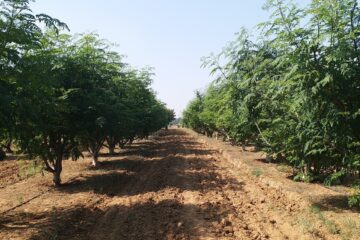Published in the August 2017 Issue
Azolla is a type of cyanobacteria that provides a significant amount of nitrogen, beneficial for crop growth. It is a free-floating fern that lives in water and contains a blue-green algae called Anabaena within its leaves, which helps fix nitrogen.
Azolla has been utilized in paddy fields across various parts of Asia for many years to boost production. It contains 0.2-0.3% nitrogen in its fresh state and 3.5% in its dry state.
Unique Features of Azolla
Azolla is unique as it does not require soil to grow and can double its biomass in 2-3 days. By fixing atmospheric carbon dioxide and converting it into organic compounds, Azolla helps reduce the impact of climate change.
Enhancing Soil Fertility and Production with Azolla
In addition to fixing nitrogen, Azolla provides multiple benefits to paddy fields. It spreads densely over the water surface, suppressing weed growth. As Azolla decomposes, it releases nitrogen, phosphorus, and other nutrients into the water, making them easily accessible to the crops.
Azolla absorbs potassium more efficiently than paddy crops. Therefore, when Azolla decomposes, it releases potassium back into the soil, benefiting the paddy. Azolla also contributes to long-term soil fertility by adding organic matter and nutrients.
Azolla can also remove heavy metals like chromium, copper, and zinc from industrial wastewater, acting as a natural purifier. By covering the water surface, Azolla reduces water evaporation and nitrogen loss, thereby conserving essential nutrients.
Method of Incorporating Azolla
Azolla can be incorporated as an intercrop or a green manure crop. As an intercrop, Azolla can be introduced into the paddy field 7-8 days after transplanting, providing substantial nitrogen. As a green manure crop, Azolla should be incorporated into the soil 3-4 days before draining the field.
Azolla does not produce seeds but propagates vegetatively. Therefore, live Azolla should be maintained in a small pond or trough throughout the year. The ideal dimensions for the growth area are 4-5 meters in length, 2 meters in width, and 0.5 meters in depth, with 250-500 grams of Azolla to be placed in this area.
Azolla Cultivation Method
- Tray Method:
- Use iron, cement, or plastic trays measuring 2×1 meters in length, 20 cm in height.
- Fill the tray with 5-6 kg of well-sieved soil.
- Add water to a depth of 5-6 cm and mix well.
- Sprinkle 300-400 grams of rock phosphate over the soil.
- Spread the Azolla over the tray and expose it to sunlight.
- Once it grows densely, stop adding water.
- Seedling Bed Method:
- Allocate half of the seedling bed for Azolla cultivation.
- Divide the bed into sections of 20×2 meters.
- Add 250 grams of rock phosphate per section and fill with water.
- After 10 days, maintain the water level at 8-10 cm.
By integrating Azolla into paddy fields, farmers can enhance soil fertility, reduce weed growth, and improve paddy yields while also mitigating the effects of climate change.
Dr. T. Udhayanandini, Dr. Vaishnavi, Dr. S. Sangamithra, Tamil Nadu Agricultural University, Coimbatore – 641 003.










